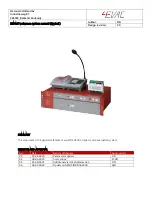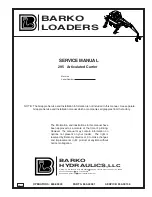
41
41
Stripe Hog Systems
WARNING
HIGH PRESSURE WATER FROM SPRAY JETS OR RUPTURED
HOSES CAN CAUSE SEVERE INJURY OR EVEN DEATH.
ALWAYS BE SURE WORK AREA IS CLEAR OF PEOPLE,
HANDS, FEET, ETC., BEFORE ENGAGING THE PTO AND THE
HIGH PRESSURE SWITCH FOR THE STRIPE HOG.
High Pressure Hoses and Fittings
The SH5500 waterblasting system operates at
ultra high pressures of up to 40,000 PSI (2,758
Bar). Therefore, it is critical that the operator and
maintenance personnel inspect the high pressure
hoses, fittings, nozzles and other components
frequently. A visual inspection of the high pres-
sure system should be conducted each day before
operating the unit. Any hose or component that
is questionable or shows any sign of deterioration,
wear or leakage should be replaced immediately
and before operating any waterblasting equip-
ment. A more thorough inspection of all high pres-
sure pumps and components should be conducted
at each routine service interval.
Check the condition of threads prior to connecting
any fittings or hoses. Use an anti-seize compound
on all fitting and hose threads to prevent “galling.”
Galling is the term for thread damage that occurs
from heat build up in the threads of stainless steel
fittings as they are tightened. Galling will destroy
the threads and lockup the fittings before they are
tight, destroying the fittings and/or hose ends,
rendering them unusable. Be careful not to get
anti-seize on the seating area of any fitting.
Always test the system with the Hog Head up
following repairs or at the start of each shift
by operating the system at low pressure first.
Then slowly bring the equipment up to operating
pressure while carefully monitoring the replaced
components.
WARNING
REFER TO THE GENERAL SAFETY SECTION OF THIS
MANUAL FOR A LIST OF PRECAUTIONS TO BE OBSERVED
WHEN OPERATING OR SERVICING ULTRA HIGH PRESSURE
EQUIPMENT. USE ONLY THOROUGHLY TRAINED PERSONNEL
TO PERFORM MAINTENANCE OR REPAIRS ON THE HIGH
PRESSURE SYSTEM.
Take care of Your Hoses. Protect the hoses from
contact with sharp objects, abrasive surfaces and
foot or wheel traffic. Add additional anti-chaffing
material to protect hoses when necessary. Never
operate the high pressure system with a hose that
is questionable.
When replacing damaged or worn hoses, check
the burst rating marked on the hose. Do not use
a high pressure hose that does not have a listed
burst rating or with a burst rating of less than
54,000 PSI (3,723 Bar).
Retire a Hose from Service if:
A) Cover is damaged and reinforcing wires are
exposed to rust and corrosion;
B) Cover is loose, has blisters or bulges;
C) Hose has been crushed or kinked;
D) End fitting shows evidence of damage, slippage
or leakage;
E) Hose has been exposed to pressures of 2 times
the operating pressure.
F) Hose has been kinked, stressed or stretched.
High Pressure Nozzles and Spray Bar
Each nozzle delivers a stream of water at ex-
tremely high pressure. The size and intensity of
the stream is determined by orifice size in the
nozzle. The performance ranges from least ag-
gressive to most aggressive.
Nozzles typically last 12-16 hours of blast time,
however, you could experience shorter or longer
nozzle life, depending on the type of surface be-
ing blasted. They should be inspected before the
start of each shift or when the operator notices a
change in performance while waterblasting.
Nozzles are easy to replace and different nozzle
sizes in a variety of spray bar configurations can
be selected to accommodate the material to be
removed and the type of substrate. The nozzle
flow chart and spray bar configuration diagrams
located in the Safety Information and Appendix
sections of this manual will provide assistance
in choosing the best nozzles for the job. As the
operator becomes more experienced, nozzle se-
lection becomes easier. You can also contact Hog
Technologies Customer Service for assistance in
selecting the proper spray bar and nozzle configu
-
ration for your job.
To check the nozzles on the Hog Head spray bar,
raise the hog head, set the parking brake, activate
Summary of Contents for Stripe Hog SH5000
Page 1: ...Operations Manual...
Page 2: ...2...
Page 4: ...4 THIS PAGE WAS LEFT BLANK INTENTIONALLY...
Page 6: ...6 THIS PAGE WAS LEFT BLANK INTENTIONALLY...
Page 8: ...8 THIS PAGE WAS LEFT BLANK INTENTIONALLY...
Page 14: ...14 THIS PAGE WAS LEFT BLANK INTENTIONALLY...
Page 20: ...20 THIS PAGE WAS LEFT BLANK INTENTIONALLY...
Page 50: ...50 THIS PAGE WAS LEFT BLANK INTENTIONALLY...
Page 58: ...58 THIS PAGE WAS LEFT BLANK INTENTIONALLY...
Page 92: ...92 Component Repair THIS PAGE WAS LEFT BLANK INTENTIONALLY...
Page 94: ...94 Component Repair...
Page 96: ...96 Component Repair...
Page 98: ...98 Component Repair...
Page 99: ...99 Fluid End Replacement Parts Appendix A Drawings and Supplies...
Page 100: ...100 THIS PAGE WAS LEFT BLANK INTENTIONALLY...
Page 104: ...104 THIS PAGE WAS LEFT BLANK INTENTIONALLY...
Page 106: ...106 THIS PAGE WAS LEFT BLANK INTENTIONALLY...
Page 110: ...110 THIS PAGE WAS LEFT BLANK INTENTIONALLY...
Page 118: ...118 THIS PAGE WAS LEFT BLANK INTENTIONALLY...
Page 121: ......
















































